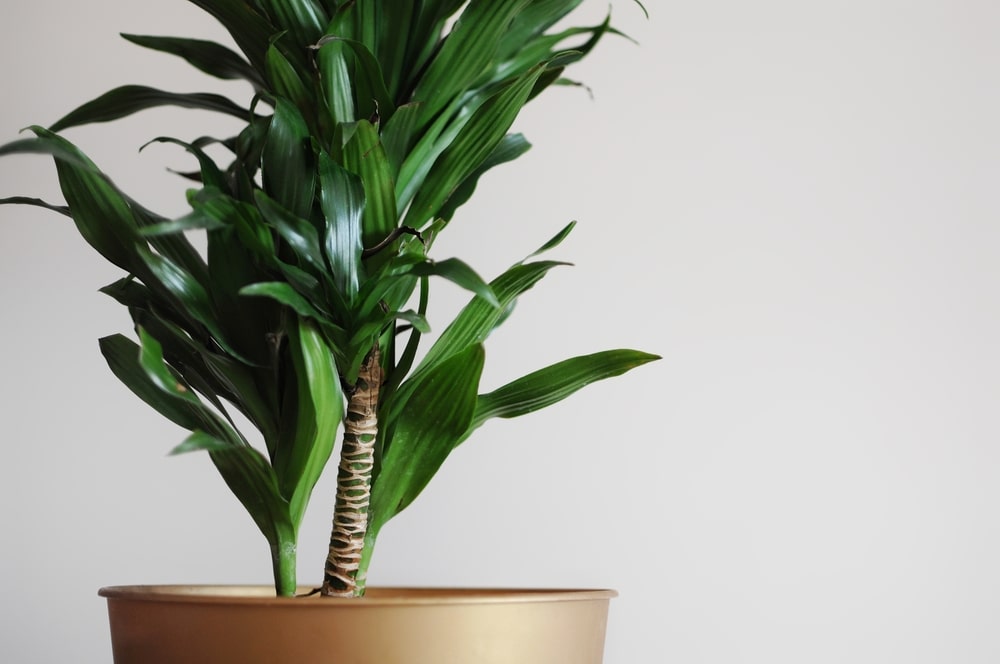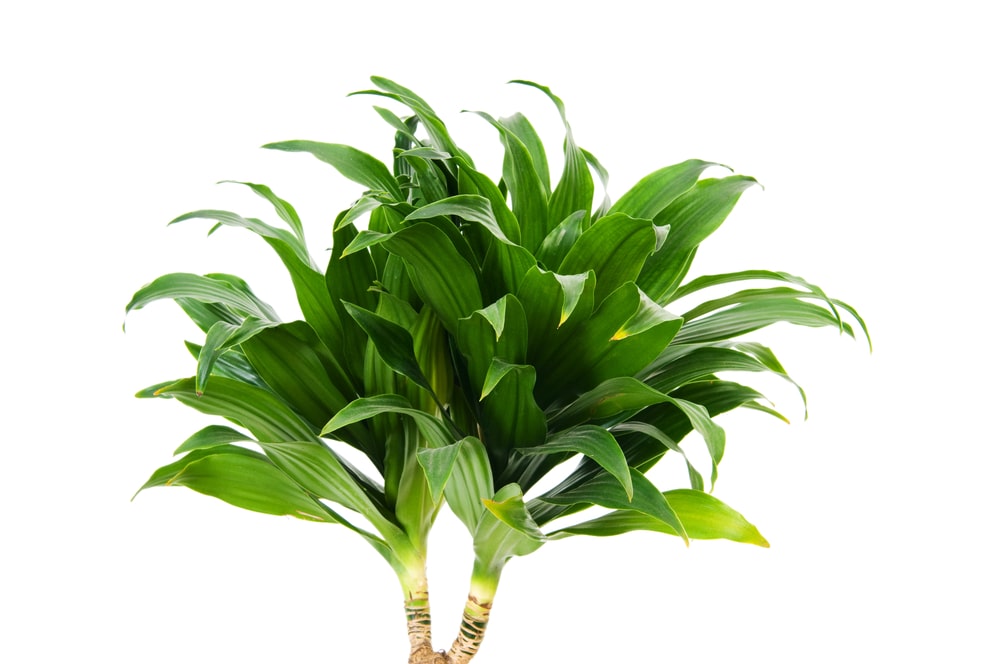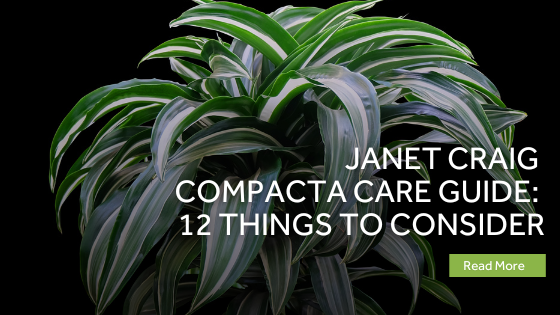Are you looking for a striking, yet easy-to-manage house plant? Look no further than the Janet Craig compacta plant. This hearty species sports vibrant dark green leaves in delicate conical shaping around the base. This plant is perfect for experts and novices alike! Read on to learn all you need to know to care for this beautiful plant.
Table of Contents
Janet Craig Compacta Overview
Sometimes referred to as the Pineapple or Dwarf dracaena plant, Compacta Janet Craig, or Dracaena Compacta, this species is stunning in any space and originates from sub-tropical regions of Africa and Asia.
The Janet Craig Compacta is a member of the Asparagaceae family and Dracaena genus. The Dracaena genus is a group of about 120 species, including trees and succulent shrubs. It fits right in as it resembles the top of a pineapple plant and has stiff, glossy, green leaves.
Janet Craig Compacta plants are popular indoor decorative plants requiring fairly low maintenance, making them extremely popular.
Here are some relatives of this magnificent plant in the Dracaena genus.
- Dracaena Reflexa: originating from Madagascar, Mozambique, and other nearby Indian ocean islands, this relative bears beautiful yellow and green leaves stemming from irregular stems.
- Dracaena Warneckii: with an uncanny resemblance to Janet Craig Compacta, the most obvious difference in this species is the white and green color striping on the leaves of this plant.
| Botanical Name | Janet Craig Compacta |
| Family | Asparagaceae |
| Genus | Dracaena |
| Origin | Sub-tropical Africa and Asia |
| Sunlight | Medium to low light |
| Watering | Low requirements, water after the top two inches are dry |
| Soil | Quick draining and aerated soil |
| Temperature | 65 – 80 degrees Fahrenheit |
| Propagation | Stem cuttings |
| Re-Potting | Once root growth surpasses pot size |
| Pests and Diseases | Mealy bugs, spider mites |
| Toxicity | Toxic to humans and pets |

Dracaena Janet Craig Compacta Plant Features
The Dracaena Janet Craig plant is well known for its stiff and glossy green foliage arranged in rosettes around the plant’s canes. The leaves grow to be 2-5 inches each, while the plant can grow up to 3-6 feet in height. This is a slow-growing plant, with a growth rate of 10cm or 4 inches per year!
It is a rare event when this plant flowers, but what a sight it is. The flower of the Janet Craig Compacta plant is white to light pink with a heavenly scent reminiscent of honey. You can find the flower at the center of the plant’s rosette when in bloom.
Related Article: 10 Best Garden Plants That Are Perfect For Your Garden
Janet Craig Plant Care Guide
Ideal Growing Place
The Janet Craig Compacta plant can be both an indoor and outdoor plant, but considerations should be made regarding location. This species requires a temperature range of 65 – 80 degrees Fahrenheit, so bear this in mind if planting outdoors. For lighting, this plant does well in medium to low light but can fare well in bright indoor/fluorescent light. If the plant receives a higher amount of lighting, it will require more watering.
With a slow growth rate, the Janet Craig Compacta has a low need for liquid fertilizer but can be given this if it has not been repotted for a few years. Due to its sub-tropical nature, humidity levels for this plant should be around 25%. If the above conditions are met, your Janet Craig Compacta plant will thrive for years.
Water
Watering your Janet Craig Compacta plant can be tricky. This species prefers soil on the dryer side of the watering spectrum. It is recommended to water once the top two inches of soil are dry. In warmer temperatures, the average time for watering is once every two weeks. In the cooler months or temperatures, once every 3-4 weeks will suffice.
However, if your plant is used indoors in bright light, you may find the soil needing watering once every week. Be wary of providing too much water as this can cause issues such as root rot. You can become more knowledgeable about your plant’s watering needs by looking to the leaves for clues. Brown tips of the leaves or brown spots can indicate that your plant is not receiving proper watering.
It is important to note that many Dracaena plants have sensitivities to minerals found in tap water, such as Boron and Fluoride. To avoid the browning of your Dracaena compacta plant, it is best to use distilled water instead of tap water.
Sunlight
The Janet Craig Compacta prefers to grow in medium to low lighting but can survive indoors with bright, indirect light. If your plant is indoors and receiving brighter light, be sure to account for this in watering your plant more often (about once per week). Try to avoid bright, direct sun.
Temperature
The Dracaena compacta plant, or Janet Craig Compacta, fares best in the temperature range of 65-80 degrees Fahrenheit. This is easier to regulate if you keep the plant indoors. However, keep this temperature range in mind if planting outdoors. It has also been found that this species has shown some tolerance to temperatures ranging around 40 degrees Fahrenheit.
Soil
Find a pot to use that has drainage holes at the bottom. Once you have the pot, you should use a well-aerating soil mix for the plant. Using soil with at least 50% rich organic mixture is suggested. You can also use lava rock for this plant and African violet soil.
Humidity
As mentioned earlier, water content for your Dracaena compacta is a delicate balance, and humidity also affects this. This plant’s ideal humidity level is about 25% and can be regulated indoors easily with a humidifier or by misting methods. If humidity is too low, your plant is at risk of drying out, but too high can lead to spontaneous overwatering.
Fertilizer
The Dracaena compacta are slow-growing, growing only about 10cm or 4 inches yearly. That being said, the fertilizer requirement is very low. If the plant has not been transferred to a new pot in a few years, it may need a bit of liquid fertilizer to help it out once every one or two months in the spring.
Pinching/Pruning
This plant is slow-growing but, after reaching maturity, can measure about 3-5 feet in height. If you want to prune this down to a smaller height, you can use sterilized shears or a knife to cut off the desired amount from the top of the main stalk. New growth will stem from below the cuts, so keep this in mind when deciding where and how much you want to remove.
Potting and Re-potting
As mentioned, Dracaena compacta plants only grow about 10 cm or 4 inches per year, making this plant last in its pot for a while. Once you have had this plant for about 3-4 years, you may notice the roots have outgrown their pot. This means the roots need more space and a larger pot to call home.
When re-potting, find a new pot about 2-3 inches larger than the previous and provide fresh soil. Once the pot is ready, transplant the Dracaena compacta into the new pot and ensure the soil has the right amount of moisture.
Growth Zone
The Janet Craig Compacta species is found in the USDA Hardiness zones of 9-11. This area of the hardiness map includes states along the southern United States and reaches up along the country’s west coast. If you plan to use this species in your outdoor garden area, check your location on the map.
Common Pests, Toxins, Diseases & Other Problems
Plants in the Dracaena genus can be affected by various pests and afflictions. For insects, mealy bugs and even spider mites can cause issues with your plant and affect the beautiful foliage. These pests can be found in the base of the leaf rosettes, so inspect your plant monthly. If you find any insects, you can wipe off your plant with neem oil or alcohol gently using a cotton cloth or paper towel.
Additionally, issues with your watering methods can appear on your plant over time. If you are overwatering or underwatering your Janet Craig Compacta, discoloring or spots on the leaves will appear in a week or two.
Propagation
After pruning, you can take the cut-off stalks and leave them in the air to dry out overnight. Once dried, plant the stalks bottom side first into small pots with drainage holes, and include fresh soil mixture. If the soil feels very dry, water in small amounts until moist. Once you see new root growth, you can again transfer these new plants into a larger pot to grow.
Janet Craig Compacta Mature Timeline
0-3 weeks: dried stem cuttings have been placed in a new pot with fresh soil and will begin to develop new root systems.
4 weeks +: In about 4-6 weeks, roots have appeared on your new plant. It is now time to transplant into a larger pot with space for roots to grow.

Janet Craig Plant FAQ
Is Janet Craig Compacta Toxic to Cats, Dogs, and Humans?
Like the other members of the Dracaena genus, the Janet Craig Compacta plant is toxic to humans and pets. If ingested, side effects can include vomiting, hypersalivation, and depression. It is best to keep this plant away from small children and pets and to seek immediate medical help if it is suspected any ingestion has occurred.
Is Janet Craig Compacta an Indoor Plant?
The Janet Craig Compacta is often found as an indoor plant and is quite popular for indoor spaces. It is important to consider the care requirements for this species, including temperature, lighting, humidity, and soil, when deciding whether to plant indoors or outdoors.
What Are These Spots on the Leaves of My Dracaena Janet Craig Compacta?
Spots can appear on the leaves of the Dracaena Janet Craig Compacta due to its sensitivity to minerals found in tap water, such as Boron and Fluoride. If this occurs, use distilled water when watering your plant.
Why Is My Janet Craig Leaves Turning Yellow?
Yellowing of the Janet Craig Compacta leaves can also indicate fluoride in the water affecting the plant. Additionally, if you are using too much fertilizer to supplement your plant, this can cause harm and cause discoloration.
Why Is My Dracaena Janet Craig Compacta Have Black Leaves?
If a few leaves or tips of the leaves are turning black, this can indicate further issues with watering. Too little moisture in the soil or air can cause leaves to turn darker in color. This discoloration can also be traced to too-high temperatures dehydrating your plant.
Why Is My Dracaena Janet Craig Compacta Have Brown Leaves?
Similar to previous discoloration concerns, brown leaves indicate issues with watering, over-fertilizing, or temperature issues. Be sure to check soil moisture, water type and amount, and fertilizer levels you are using.
The Bottom Line
The Janet Craig Compacta plant is a stunning addition to any indoor or garden space. It is a beautiful houseplant that is perfect for those who are looking for a low-maintenance addition to their home. This plant is known for its ability to tolerate low light conditions and can even thrive in indirect sunlight. The vibrant, glossy green leaves and rare flowering make this plant stand out, and are bound to brighten your space.
Last Updated on August 25, 2022 by Gustaf Johansson




